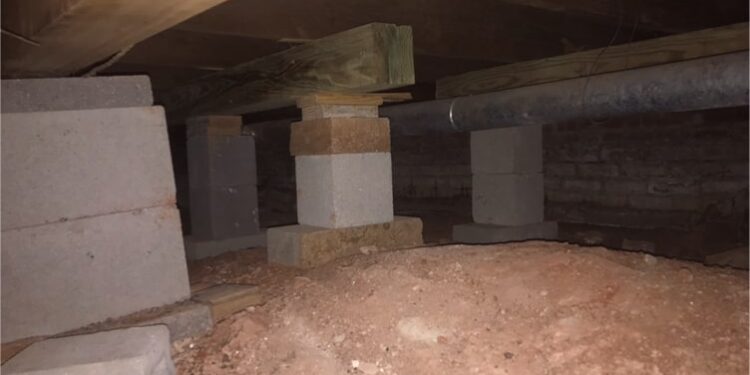Are you planning to get yourself a new home? You will certainly research every detail of your new home, but have you thought about the type of foundation your house will have? How about concrete slabs or piers and beams? The pier-and-beam foundation is among the most stable, but have you considered checking the repairing aspect well? Well, in this blog we run through the pier and beam foundation repair, its purpose, the common cause and a few ways to get it repaired.
What is the On-going Pier Foundation Repair in the Industry?
There are three types of foundation repair prevailing in the modern construction industry:
Concrete pier foundation –
It depends on the strength of the soil (load-bearing strata) to construct these solid concrete piers. Homeowners can pick this one if their solid ground is deep.
Concrete blocks –
You can make a pier and beam foundation with cinder blocks.
Drilled caissons –
A drilled caisson is a concrete and rebar structure called a drilled pier. The steel cages and other reinforcements on these piers allow them to penetrate deep into the soil, providing a stable foundation for larger structures.
What is the Purpose of the Pier and Beam Foundation?
Let’s start by understanding how a pier and beam foundation functions.
Buildings, porches, decks, and other outdoor structures commonly have pier-and-beam foundations.
A pier-and-post structure supports horizontal wood or steel beams using vertical columns or posts. A patio or shed attached to a house might be constructed using this method (e.g., a shed).
Among them other applications of pier and beam foundation are:
- Double-wides
- Mansions
- Churches
- Strip malls
In contrast to concrete slabs, staggered beams provide solid support for the structure above, providing better drainage. So, depending on your soil type, pier and beam foundations may be a great choice when choosing a suitable foundation for various structures, large and small.
What are the Common Causes of the Pier and Beam Foundation?
A pier or beam foundation can also suffer problems caused by too much or too little water, as with any other type of foundation. As the soil absorbs water, it will expand, and as it dries, it will shrink.
Over time, this can destabilize a pier and beam foundation due to movement in the soil and the foundation. Concrete piers should be drilled into competent soil strata or bedrock to ensure their strength, particularly those on pier and beam foundations.
Further, wood-eating pests such as termites can also affect a pier and beam foundation. Nevertheless, it’s possible to catch this problem early before it can cause significant damage since pier and beam foundations have crawl spaces that are easily accessible for inspections.
How can the Pier and Foundation be Repaired?
A foundation repair contractor may find it easy to access and correct problems in some cases. It’s easier to fix a slab-on-grade foundation problem if they can access the failing parts easily. However, fixing pier and beam foundation problems can be more difficult, complex, and expensive if accessing the problem areas is difficult.
Based on the ease, cost, and difficulty, the following foundation repair remedies are discussed:
Reshimming
You can reshim your pier and beam foundation parts to make small but more frequent adjustments to the snugness. Reshimming can fix things that become loose or move a little when they get loose.
The cost of resizing a pier and beam home would be between $1,200 and $1,800 and take about one day. It is a small price if it prevents larger issues from developing.
The process is similar to preventative maintenance for a crawl space home. A thorough inspection is still required despite properly installed supporting material and regular maintenance.
Every 3-5 years, resiming should be done to fill gaps between your foundation’s and settled piers. By doing this regularly, your pier and beam foundation will stay in good shape, and bigger problems won’t arise.

Replacing wood
It is necessary to replace floor joists when they rot, break, warp, or wear out. The foundations might require sills and joists when they need to be more adequately supported.
It can be a small job or a massive overhaul and rebuilding project, depending on how much wood needs replacing and how easy it is to access the problem area.
It’s always tricky to replace wood under a house. Removing the damaged section of the crawl space and temporarily supporting its adjacent parts is recommended.
An extensive project could cost a wood replacement job $10,000 to $20,000.
Add Pier Stack
A block may degrade or disintegrate over time, or there may not be enough. Adding piers to a foundation will help distribute weight more evenly and smooth out bowing floors. If any are damaged, they can be repaired/replaced.
Based on your home size and access to the crawl space, this repair could take two or more days. The average cost can be around $4,000 and $6,000 to bring the pier and beam back on working order.
Underpin the Beam
There are many times when pier and beam homes settle only inside the interior support areas, which gets underbuilt and undersupported, causing the weight distribution problem.
Adding support to settled areas requires drilled bell-bottom piers or concrete pilings.
For long-term stability, some foundation repair methods work better than others based on the weight of the home.
The price will vary depending on the number of supports and the repair method.
Conclusion
You should contact a foundation repair company immediately if you notice cracks in your foundation, shifting floors, bowing walls, water damage, or soil erosion around your home’s foundation. You can estimate the cost of repairing your home quickly with the help of the foundation repair companies available around your area. Alongside, you can also examine their reviews and certifications to gain the best foundation repair service from the service provider.





